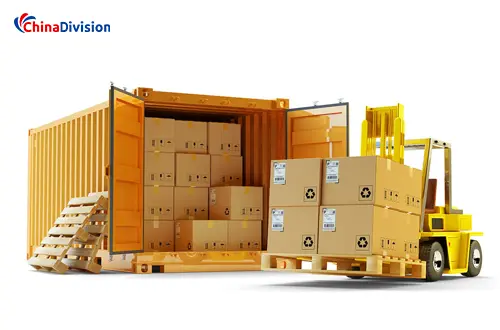How to Ensure Cargo Safety Through Container Loading Skills?
The professionalism of container loading is directly related to the safety, transportation efficiency and logistics costs of cargo. Whether it is a B2B enterprise or an e-commerce seller, mastering loading skills can not only reduce transportation risks, but also optimize costs.
Table of Contents
As a professional third-party logistics service provider, Chinadivision is committed to providing efficient and safe container loading services for B2B enterprises and e-commerce sellers. This article will introduce the best practices and techniques of container loading in detail to help you optimize logistics processes and ensure smooth transportation of goods.
Basic methods of container loading

All manual packing
Applicable to small or manually stackable goods, such as light goods or electronic products. Manual operations require special attention to the instructions on the packaging (such as "do not invert") and use cushioning materials to protect fragile items.
Mechanically assisted stacking (forklift + manual collaboration)
The goods are moved into the box by forklift and then stacked manually. This method is more efficient and suitable for medium-sized goods, such as household goods or consumer goods, but it is necessary to ensure that the goods are stacked tightly to avoid movement.
Fully mechanized packing
For palletized goods or large quantities of goods and palletized goods, using fully mechanized packing can improve efficiency and reduce labor costs. Use a forklift to stack the goods neatly in the box, but be aware of the physical limitations of the forklift's free lifting height and the container's door frame.
Key skills and precautions for loading
Observe the maximum load
The total weight of the goods in the box must not exceed the maximum load of the container. The maximum load of a container is the total weight of the container minus the deadweight of the container. Usually, the total weight and deadweight are marked on the container door. Make sure that the total weight of the goods loaded in the box does not exceed the maximum load of the container to avoid safety problems caused by overloading.
Clearly distinguish between heavy and light goods
Determine whether it is heavy or light by the density of the goods, and plan the packing order in advance. If the density of the goods is greater than the unit volume weight of the box, it is heavy; otherwise, it is light. Timely distinction between heavy and light goods helps to arrange the loading order reasonably and improve packing efficiency. Heavy goods should be placed on the bottom of the box first, and light goods should be stacked on top to ensure that the weight is evenly distributed.
Ensure a balanced load
When loading, keep the bottom of the box evenly loaded to avoid the center of gravity of the goods shifting to one end. Uneven load may cause the box to tilt or even damage during transportation. When loading, try to distribute heavy goods evenly on the bottom of the box to avoid one side being too heavy and causing the container to tilt.
Avoid concentrated loads
For heavy goods such as machinery and equipment, be sure to use wooden boards or other cushioning materials to disperse the load. The safe load units on the bottom of a standard container are as follows:
20-foot container: 1330x9.8N/m²
40-foot container: 980x9.8N/m²
Use loading tools correctly
For manual loading, be sure to avoid using unsafe tools (such as hand hooks) to ensure that the load is tight and stable to prevent the goods from moving during transportation. Pay attention to the loading and unloading instructions on the packaging, such as "do not invert", "lay flat", and "put vertically". The goods in the box should be loaded neatly and stacked tightly. For goods that are easy to loosen and pack fragile goods, use padding or insert plywood between goods to prevent the goods from moving in the box.
Accurately calculate pallet loading
When loading pallets, it is necessary to accurately measure the internal dimensions of the container and the dimensions of the outer packaging of the goods in order to calculate the number of loaded pieces, reduce abandoned space, and maximize loading capacity. Reasonably arrange the placement direction of the pallets to ensure that the goods are tightly stacked and avoid gaps.
Pay attention to the forklift loading height limit
When loading with a forklift, it will be limited by the free lifting height of the machine and the height of the mast. If conditions permit, load two layers of goods at a time to ensure that there is enough space between the upper and lower goods. If conditions do not allow loading two layers at a time, consider the free lifting height of the forklift and the height that the mast may rise when loading the second layer.
Packaging protection and bundling
Even if it is to save space, be sure to provide appropriate packaging protection for the goods to avoid damage to the goods due to naked loading. For large machinery or building materials, bundling and tying must be used to ensure stability.
Common problems and solutions
How to avoid damage to goods during transportation?
Ensure that the goods are properly packaged and use cushioning materials when loading to avoid concentrated loads.
How to improve loading efficiency?
Arrange the loading order reasonably, distinguish between heavy and light goods, and ensure load balance.
How to reduce abandoned space and load more goods?
Optimize pallet loading, arrange the placement direction of pallets reasonably, and ensure that the goods are tightly stacked.
ChinaDivision's professional loading solution
As a professional third-party logistics service provider, ChinaDivision provides one-stop container loading and international transportation services to ensure that your goods are delivered safely and efficiently to global destinations:
Experienced team: With rich experience in packing and transportation, we provide you with customized packing solutions.
Advanced operating equipment: Use modern forklifts and mechanical equipment to improve loading efficiency and ensure cargo safety.
Comprehensive packaging and reinforcement services: Provide special protection measures such as shockproof, anti-slip, and waterproof according to the type of goods.
Real-time monitoring and support: Through the digital management system, we can control the progress of cargo transportation at any time and provide professional consultation.
Make loading more professional and transportation more secure
Container loading is an operation that requires technology and experience. Professional loading skills not only improve transportation efficiency, but also avoid potential risks. ChinaDivision has many years of global fulfillment and international shipping experience, helping B2B companies and e-commerce sellers simplify their logistics processes and ensure safe, efficient and professional container loading. By working with ChinaDivision, you can enjoy a worry-free service from packing to international delivery. Want to learn more about our packing and transportation services? Contact ChinaDivision now to ensure that your goods can travel safely around the world!





